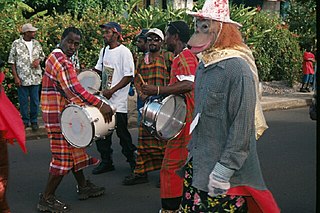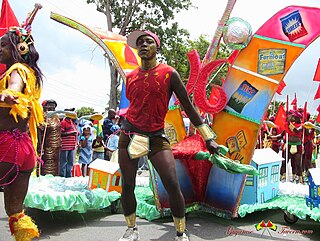Calypso is a style of Caribbean music that originated in Trinidad and Tobago during the early to mid-19th century and spread to the rest of the Caribbean Antilles by the mid-20th century. Its rhythms can be traced back to West African Kaiso and the arrival of French planters and their slaves from the French Antilles in the 18th century.
The music of Trinidad and Tobago is best known for its calypso music, soca music, chutney music, and steelpan. Calypso's internationally noted performances in the 1950s from native artists such as Lord Melody, Lord Kitchener and Mighty Sparrow. The art form was most popularised at that time by Harry Belafonte. Along with folk songs and African- and Indian-based classical forms, cross-cultural interactions have produced other indigenous forms of music including soca, rapso, parang, chutney, and other derivative and fusion styles. There are also local communities which practice and experiment with international classical and pop music, often fusing them with local steelpan instruments.

The music of Dominica includes a variety of genres including all the popular genres of the world. Popular music is widespread, with a number of native Dominican performers gaining national fame in imported genres such as calypso, reggae, soca, kompa, zouk and rock and roll. Dominica's own popular music industry has created a form called bouyon, which combines elements from several styles and has achieved a wide fanbase in Dominica. Groups include WCK, Native musicians in various forms, such as reggae, kadans (Ophelia Marie, and calypso, have also become stars at home and abroad.
The music of the Lesser Antilles encompasses the music of this chain of small islands making up the eastern and southern portion of the West Indies. Lesser Antillean music is part of the broader category of Caribbean music; much of the folk and popular music is also a part of the Afro-American musical complex, being a mixture of African, European and indigenous American elements. The Lesser Antilles' musical cultures are largely based on the music of African slaves brought by European traders and colonizers. The African musical elements are a hybrid of instruments and styles from numerous West African tribes, while the European slaveholders added their own musics into the mix, as did immigrants from India. In many ways, the Lesser Antilles can be musically divided based on which nation colonized them.
J'ouvert or Jour ouvert is a traditional festival known as "break day" or the unofficial start of Carnival, which takes place on the Monday before Ash Wednesday. The festival, with origins in Trinidad, traditionally begins at 2 a.m. and continues until mid-morning on Monday. J'Ouvert revellers cover their bodies in coloured paints, mud, pitch oil, dress as blue or red devils to dance the streets as an expression of liberation from the constraints of the past and in celebration of the ancestors who have gone before them. Other neighbouring islands, and in areas where Caribbean people have immigrated, celebrate J'ouvert before the official start of Carnival Mas, where the more elaborate costumes are on display and danced through the city streets.

The Toronto Caribbean Carnival, formerly and affectionately known as Caribana, is a festival of Caribbean culture and traditions held each summer in the city of Toronto, Ontario, Canada. It is a pan-Caribbean Carnival event and has been billed as North America's largest Festival, frequented by over 1.3 million tourists each year for the festival's Grand Parade and an overall attendance of 2.3 million.
The music of Saint Vincent and the Grenadines includes thriving music scenes based on Big Drum, calypso, soca, steelpan and also reggae. String band music, quadrille, bélé music and traditional storytelling are also popular.

The music of Antigua and Barbuda is largely African in character, and has only felt a limited influence from European styles due to the population of Antigua and Barbuda descending mostly from West Africans who were made slaves by Europeans.

The Trinidad and Tobago Carnival is an annual event held on the Monday and Tuesday before Ash Wednesday in Trinidad and Tobago. This event is well known for participants' colorful costumes and exuberant celebrations. There are numerous cultural events such as "band launch fetes" running in the lead up to the street parade on Carnival Monday and Tuesday. It is said that if the islanders are not celebrating it, then they are preparing for it, while reminiscing about the past year's festival. Traditionally, the festival is associated with calypso music, with its origins formulated in the midst of hardship for enslaved West and Central Africans; however, recently Soca music has replaced calypso as the most celebrated type of music. Costumes, stick-fighting and limbo competitions are also important components of the festival.

Mashramani, often abbreviated to "Mash", is an annual festival that celebrates Guyana becoming a Republic in 1970.
The culture of Trinidad and Tobago reflects the influence of Indian-South Asian, African, Indigenous, European, Chinese, North American, Latino, and Arab cultures. The histories of Trinidad and Tobago are different. There are differences in the cultural influences which have shaped each island. Trinidad and Tobago is an English-speaking country with strong links to the United Kingdom.

The West Indian Day Parade Carnival is an annual celebration of West Indian culture, held annually on around the first Monday of September in Crown Heights, Brooklyn, New York City. It is organized by the West Indian American Day Carnival Association (WIADCA).
Shermain Sunja Jeremy is an Antiguan singer and beauty pageant titleholder, winner of the Miss Antigua and Barbuda Carnival Queen Show competition in 2002 and Jaycee's Caribbean queen show that year. In the Miss World 2004 pageant, she won the Miss World Talent competition.
Chanté mas and Lapo kabrit is a form of Carnival music of Dominica. It is performed by masquerading partygoers in a two-day parade, with a lead vocalist (chantwèl), who is followed by the responsorial chorus (lavwa), with drummers and dancers dancing backwards in front of the drummer on a tambou lélé. The Carnival has African and French roots and is otherwise known as Mas Dominik, the most original Carnival in the Caribbean.
El-A-Kru is an Antiguan soca band. The name derives from "Little Antigua Crew".

The traditions of West Africa and the United Kingdom have the biggest impact on the culture of Antigua and Barbuda. As a crucial component of its culture, Antigua and Barbuda also has its own creole language.
Sir MacLean Emanuel, better known as King Short Shirt, is an Antiguan singer, best known as one of Antigua's longest standing and most successful calypsonians, but later producing gospel music.

Claudette Peters, OH is an Antiguan soca and soul singer-songwriter. Peters is best known as Antigua's "Soca Diva" and the Queen of Soca of Antigua and Barbuda was the lead vocalist for the Taxik Band. Claudette has multiple Jumpy and Groovy Party Monarch crowns in which she won from the annual Antigua Carnival's Party Monarch Competition to justify her claim to fame.

Franklyn McIntosh is a St Vincent-born pianist and arranger of calypso and soca music. He is recognized as one of the pioneer music arrangers who helped usher in the soca style of West Indian popular music in the 1970s and 1980s.














